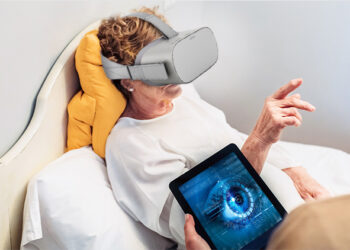In the evolving landscape of healthcare, a new and powerful solution is emerging to combat the growing burden of chronic illnesses: digital therapeutics (DTx). These are evidence-based, clinically validated software programs that deliver therapeutic interventions to patients, helping them manage, prevent, and treat a wide range of chronic conditions. Unlike general wellness apps, DTx are held to a rigorous standard, often requiring regulatory approval and clinical trials to prove their efficacy. They represent a fundamental shift from a passive, one-size-fits-all approach to a proactive, personalized, and patient-centered model of care. This comprehensive article will delve into the rise of digital therapeutics, their groundbreaking applications, and the challenges and opportunities that lie ahead, offering a glimpse into a future where technology and medicine work hand-in-hand to empower patients and transform chronic disease management.
The Need for a New Approach

Chronic illnesses such as diabetes, hypertension, and mental health disorders are the leading cause of death and disability worldwide. The traditional healthcare model, which often relies on periodic in-person visits and medication, is not always sufficient to manage these conditions effectively. This is where digital therapeutics fills a critical gap. They provide continuous, on-demand support and personalized interventions that are not always feasible in a traditional clinical setting.
A. Patient-Centered Care: DTx puts the patient in the driver’s seat, empowering them with the tools and knowledge to actively manage their own health. The programs are designed to be engaging, interactive, and easy to use, increasing patient adherence and engagement.
B. Continuous Support: Chronic conditions don’t take a day off. DTx provides continuous support, offering timely reminders, coaching, and data tracking that can help patients make better decisions in real-time, preventing potential crises.
C. Bridging Gaps in Care: In many areas, there is a shortage of specialists and long wait times for appointments. DTx can help bridge this gap by providing access to evidence-based therapeutic interventions that can be used from the comfort of a patient’s home.
D. Data-Driven Personalization: By collecting and analyzing patient data, DTx can provide a highly personalized experience. The programs can adapt to a patient’s progress, offering targeted interventions and insights that are tailored to their unique needs and behaviors.
E. Cost-Effective Solutions: DTx can be a more cost-effective solution than traditional treatments. They can reduce the need for expensive hospital visits, emergency room care, and in some cases, even medication, leading to significant savings for both patients and the healthcare system.
Groundbreaking Applications of DTx in Chronic Illnesses
Digital therapeutics are being applied across a wide range of chronic conditions, with each application tailored to the specific needs of the patient and the disease.
A. Diabetes Management: DTx programs for diabetes often combine education, remote coaching, and data tracking. They can help patients monitor their blood glucose levels, track their diet and exercise, and receive personalized feedback to help them manage their condition. These programs have been shown to improve glycemic control and reduce the risk of complications.
B. Mental Health Disorders: DTx is proving to be a powerful tool in the treatment of mental health conditions like anxiety, depression, and insomnia. The programs often use cognitive-behavioral therapy (CBT) techniques to help patients reframe negative thought patterns and develop coping strategies. They can also provide guided meditation, mindfulness exercises, and tools for mood tracking.
C. Hypertension and Cardiovascular Health: DTx for hypertension focuses on lifestyle changes. The programs provide personalized coaching on diet, exercise, and stress management, and they can integrate with connected devices like smart blood pressure cuffs to track a patient’s progress and provide real-time feedback.
D. Substance Use Disorders: DTx is being used as a supplementary treatment for substance use disorders. The programs often provide therapeutic interventions, peer support communities, and tools for tracking cravings and triggers. They can serve as a valuable support system for patients in recovery, particularly in between therapy sessions.
E. Chronic Pain Management: Chronic pain can be debilitating. DTx programs for chronic pain often combine education, physical therapy exercises, and mindfulness techniques to help patients manage their symptoms and improve their quality of life. The programs can be a valuable complement to traditional pain management strategies, reducing the reliance on medication.
F. Respiratory Conditions: For conditions like asthma and Chronic Obstructive Pulmonary Disease (COPD), DTx can help patients monitor their symptoms, track their medication use, and learn how to manage their condition. The programs can also provide alerts and reminders, helping to prevent potential crises.
The DTx Ecosystem

The digital therapeutics ecosystem is a complex web of technology, healthcare providers, and regulatory bodies. For a DTx program to be effective and trustworthy, it must navigate this ecosystem successfully.
A. Clinical Validation and Regulatory Approval: A key differentiator between DTx and general wellness apps is clinical validation. DTx programs undergo rigorous clinical trials to prove their safety and efficacy. They are often subject to regulatory approval by bodies like the FDA, which gives doctors and patients confidence in their therapeutic value.
B. The Role of Healthcare Providers: DTx is not meant to replace healthcare providers; it is meant to augment their care. Doctors can now prescribe DTx as they would a medication. The programs often provide the doctor with a dashboard to track their patient’s progress, allowing for more informed and personalized care.
C. Partnerships with Insurance Companies: For DTx to be accessible, it must be covered by insurance. Many insurance companies are now recognizing the value of DTx and are beginning to cover the cost of these programs, particularly for chronic conditions where they can lead to significant cost savings and improved health outcomes.
D. The Patient Journey: The patient journey with DTx is seamless and empowering. It begins with a doctor’s prescription, followed by a simple download and onboarding process. The program then becomes a daily companion, providing support, guidance, and real-time feedback to help the patient manage their condition.
E. Ongoing Research and Development: The DTx industry is a hotbed of innovation. Companies are constantly researching new applications, refining their algorithms, and incorporating new technologies like AI and virtual reality to create more engaging and effective programs.
Challenges and the Future of DTx
While the potential of digital therapeutics is immense, there are still challenges to overcome before they become a standard part of healthcare.
A. Building Trust and Awareness: Many patients and providers are still unfamiliar with DTx. Building trust and awareness requires a concerted effort to educate the public and the medical community about the science and benefits behind these programs.
B. Interoperability and Data Integration: DTx programs generate a wealth of patient data, but for this data to be truly useful, it needs to be integrated with a patient’s electronic health record (EHR). Achieving interoperability between different systems is a major technical and logistical challenge.
C. Equitable Access: The “digital divide” remains a concern. Not all patients have access to a smartphone, a reliable internet connection, or the digital literacy required to use these programs. Ensuring equitable access to DTx is a critical ethical and social challenge.
D. Regulatory Landscape: While regulatory bodies are adapting, the process for approving DTx is still evolving. A clear and standardized regulatory framework is needed to streamline the process and ensure that safe and effective programs can reach patients in a timely manner.
E. Reimbursement and Business Models: The business models for DTx are still being worked out. While some are covered by insurance, others are direct-to-consumer. A sustainable reimbursement model is needed to ensure that these programs are accessible and profitable for the companies that develop them.
The future of digital therapeutics is a future of personalized, proactive healthcare. As technology becomes more sophisticated, we can expect to see DTx that are deeply integrated with a patient’s entire digital health ecosystem, from their wearable devices to their electronic health records. AI will play an even greater role in creating highly personalized and adaptive interventions. The goal is to create a healthcare system that is not only reactive but also predictive, helping patients prevent chronic illnesses before they even begin.
Conclusion
Digital therapeutics represents a paradigm shift in the management of chronic illnesses. By leveraging the power of technology, these clinically validated software programs are empowering patients, providing continuous support, and delivering personalized interventions that are proven to be safe and effective. They are a testament to the idea that medicine can be more than just a pill; it can be an engaging, interactive, and empowering experience that helps patients take control of their health. From diabetes management to mental wellness and chronic pain, DTx is already making a profound impact, and its potential is only just beginning to be realized.
However, the journey ahead is not without its challenges. Building trust, ensuring equitable access, and creating a clear regulatory framework are crucial steps in ensuring that DTx can reach its full potential. The future of healthcare is a hybrid model, one that seamlessly integrates in-person clinical care with digital therapeutic interventions. It is a future where technology is used not to replace human connection but to augment it, allowing doctors and patients to work together in a more collaborative and informed way. The rise of digital therapeutics is a powerful reminder that the most effective solutions are often those that put the patient at the center of their own care. As we move forward, DTx will be a key driver in creating a healthcare system that is not only more efficient and cost-effective but also more compassionate and personalized for all.










Discussion about this post